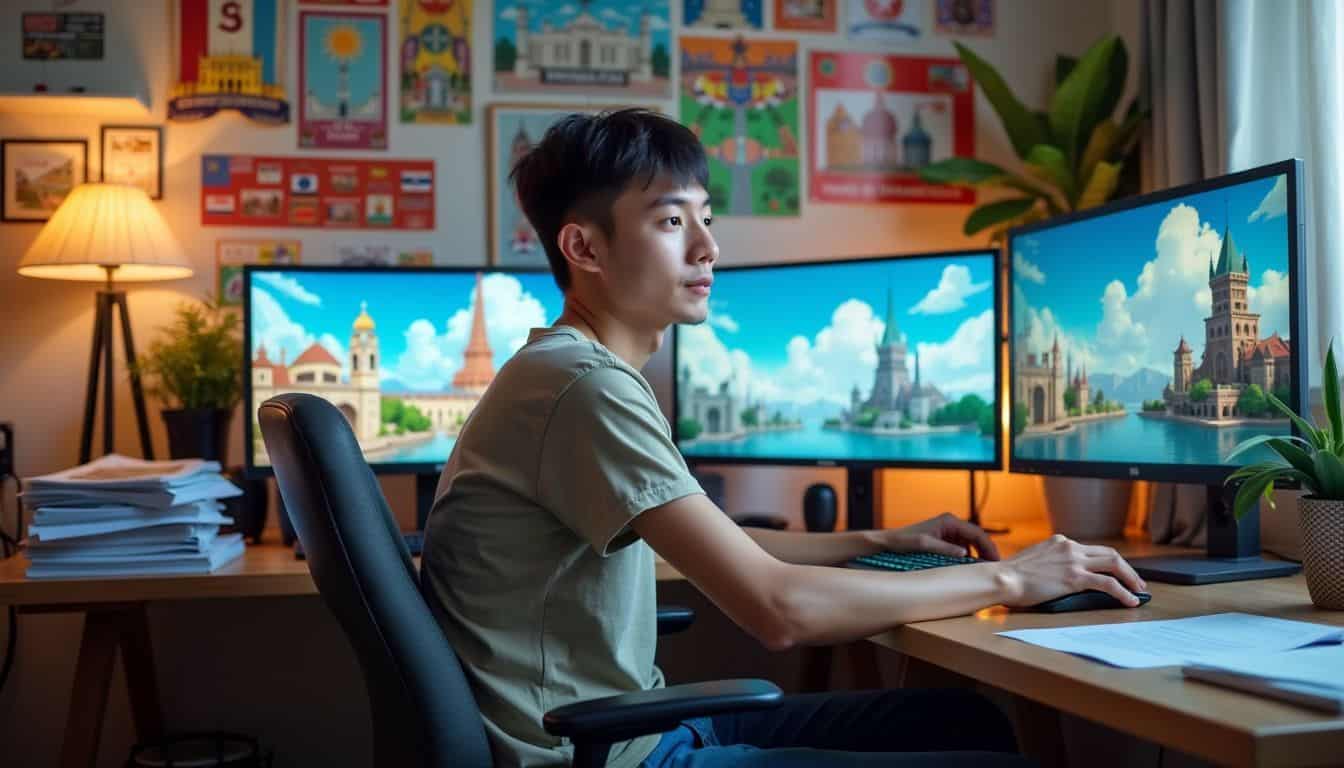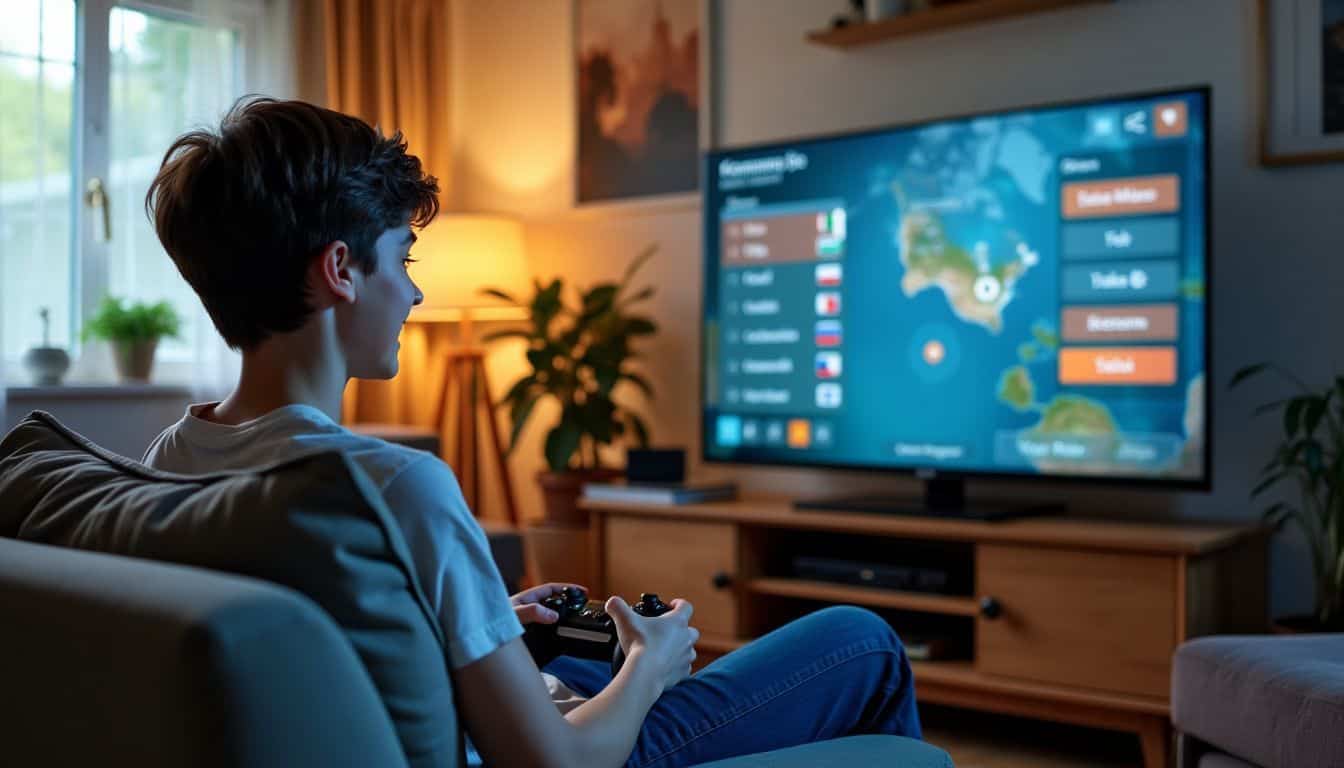Ever played a game that felt… off? Like something was lost in translation? That’s where video game localization comes in. What is localization in video games, you ask? It’s the art of adapting games for different markets worldwide. 2 This process goes beyond simple translation – it’s about making games feel native to players across the globe. 1
Ready to level up your gaming knowledge? Let’s play! 3
Key Takeaways
Video game localization adapts games for different markets worldwide, going beyond translation to adjust art, packaging, and mechanics to make games feel native to players across cultures.
The global gaming market is huge, set to make $282 billion in 2024, with 3.02 billion gamers worldwide. China, the US, and Japan are the biggest markets.
Key elements of game localization include translating text, adapting to cultural norms, implementing technical changes, and localizing audio and visuals.
Challenges in game localization include navigating cultural sensitivities, addressing technical complexities, and maintaining consistency across game elements.
Emerging trends in game localization include the use of AI and automation to speed up the process, and a growing need for localized voice overs to enhance player immersion.
Table of Contents
Understanding Video Game Localization

Video game localization is like giving a game a passport. It’s the process of adapting a game for different markets. This goes beyond just translating words. It involves adjusting art, packaging, and even game mechanics.
The aim? To make players feel like the game was made specifically for them. Localization helps games cross borders and cultures easily. 1
Localization is the key that unlocks the door to global gaming success.
Think of it as a makeover for your favorite game. Take Pac-Man, for example. It was originally called “Puck-Man” in Japan. But they changed it for the U.S. market. Why? To prevent pranksters from turning the “P” into an “F”.
That’s localization in action! It’s not just about language. It’s about making smart changes that suit each market. Good localization can make or break a game’s success abroad. 2 Let’s explore why localization is so important in the gaming world.
For more info on related services, check out this simultaneous translation service.
The Role of Localization in the Gaming Industry

Localization opens doors to new markets for game developers. It helps games speak to players worldwide, boosting sales and fan bases across cultures.
Reach Global Audiences

Game makers want their games to be played all over the world. That’s why they use localization. It helps them reach players in different countries who speak different languages. The global gaming market is huge – it’s set to make $282 billion in 2024! 4 China, the US, and Japan are the biggest markets.
With 3.02 billion gamers worldwide, there’s a lot of potential for growth.
Localization isn’t just about changing words. It’s about making the game feel like it was made for each country. This means tweaking cultural references, adjusting visuals, and even changing game mechanics.
For example, Nintendo often changes character names and designs for different regions. They turned “Puck Man” into “Pac-Man” for Western audiences. Smart localization can boost player engagement and help games succeed in new markets. 3 Next, let’s look at how localization boosts player engagement.
Boost Player Engagement

Reaching global audiences is great, but keeping players hooked? That’s the real win. Game localization boosts player engagement big time. It’s not just about words – it’s about feeling.
When gamers see their language and culture in a game, they connect more deeply. 5
Take “The Witcher 3: Wild Hunt” for example. Its excellent localization made players worldwide feel at home in its fantasy world. The game’s dialogue – all 450,000 words of it – was carefully adapted for each market.
This attention to detail paid off. Players spent hours exploring every part of the game world. They weren’t just playing; they were living the story. That’s the power of good localization.
It turns casual gamers into die-hard fans, ready to spread the word about their new favorite game. 3
Meet Local Legal Standards

Legal rules matter in game localization too. Each country has its own laws about what’s okay in games. Game makers must follow these rules to sell their games worldwide. 5
Germany’s USK, for example, is tough on blood and hate symbols. That’s why Team Fortress 2 had no blood or body parts in its German version. China bans games that go against its values.
Hearts of Iron got banned there in 2002. Smart game companies study these laws before they localize. It helps them avoid costly mistakes and keeps their games on shelves across the globe. 6
Key Elements of Video Game Localization

Game localization isn’t just about changing words. It’s a whole package deal! Want to know what makes a game truly global? Keep reading….
Translate Game Text

Translating game text is a big deal in video game localization. It’s not just about swapping words from one language to another. Nope, it’s way more complex than that. Game devs need to tackle dialogue, menus, and even in-game docs. 5 They’ve got to make sure everything reads smoothly in the target language.
All your base are belong to us – a classic example of poor translation in gaming.
But here’s the kicker: it’s not enough to just translate. Pros use “transcreation” to really connect with local gamers. This means tweaking jokes, puns, and cultural references so they hit home.
It’s a tricky balance between staying true to the original and making it feel natural for new players. And get this – language work can sometimes delay game releases in Europe. 7 Talk about a tough job!
Adapt to Cultural Norms
Cultural norms can make or break a game’s success in different markets. Smart game makers tweak their products to fit local tastes and values. They might change a character’s age, like in Fatal Frame, to match what players expect. 2 Or they could adjust how blood and violence are shown to avoid offending folks. It’s not just about words – it’s about the whole package. 8
Game creators must walk a fine line. They need to keep their brand intact while making the game feel “local.” Kate Edwards, a pro in this field, stressed how crucial cultural know-how is at a big gaming event in 2006.
It’s a tricky dance, but when done right, it helps games win hearts across the globe. For more on how games vary, check out different video game genres.
Implement Technical Changes
Technical changes are crucial in game localization. It’s more than just replacing words. Developers adjust game code, modify user interfaces, and manage character limits. These changes ensure the game runs well in different languages.
For instance, German text is often longer than English. This means adjusting text boxes and menus to fit. 1
Game engines are key in this process. Modern ones like Unity simplify handling multiple languages. They allow developers to store text separately from code. This setup makes updating translations easier…
and helps avoid those annoying hard-coded text issues that were common in older games. Take Tony Hawk’s Pro Skater – its early versions had some translation problems due to technical limitations. 9
Localize Game Audio and Visuals
Game audio and visuals are key parts of localization. Dubbing voices and tweaking graphics help games feel native to players worldwide. For example, FIFA 18 added Arabic commentary, which boosted sales big time.
Lip-syncing matters too. New dialogue must match character mouth movements in cut-scenes. It’s tricky, but it makes games more immersive for global gamers. 5
Localization is like giving your game a passport to travel the world. 6
Visuals need love too. Developers might change character outfits or tweak environments to fit local tastes. They’ll also adapt UI elements like menus and icons. Sometimes, they’ll even swap out entire characters or storylines.
It’s all about making the game feel right for each market. As one dev put it:.
Challenges in Video Game Localization

Game localization isn’t a walk in the park. It’s full of tricky hurdles that can trip up even the most seasoned pros. From cultural no-nos to tech headaches, localizers have their work cut out for them.
Navigate Cultural Sensitivities
Cultural sensitivity is a big deal in game localization. It’s not just about changing words. You need to get the whole vibe right. Games often have jokes, references, and themes that might not fly in other countries.
That’s where cultural experts come in handy. They help game makers avoid oops moments that could upset players or even break local laws. 10
Getting cultural stuff wrong can be a real headache. It might mean redoing parts of the game, which costs time and money. Or worse, it could lead to bad press or even bans in some places.
Smart game companies work with local pros to catch these issues early. They tweak everything from character designs to storylines to make sure the game feels just right for each market. 11 Next up, let’s talk about the tech side of localization.
Address Technical Complexities
Game localization isn’t just about words. It’s a tech puzzle, too. Devs face tricky issues with UI and gameplay when adapting for new markets. 10 Old games often lack modern localization tools, making updates tough.
Screen space can be a headache – fitting translated text into tight spots is no joke.
Localization is like fitting a square peg in a round hole… but in 50 different languages.
Fixing these snags takes skill and creativity. Teams must tweak code, adjust layouts, and sometimes even change game mechanics. It’s not uncommon to see entire UI overhauls or gameplay tweaks to make a game work in a new language. 11 This process can be time-consuming and costly, but it’s key to nailing that global gaming glory.
Maintain Consistency in Game Elements
Technical hurdles are just the start. Keeping game elements consistent is another big challenge. It’s like juggling while riding a unicycle – tricky but crucial.
Gamers spot inconsistencies fast. A character’s voice changing mid-game? That’s a mood killer. Dialogue that doesn’t match the subtitles? Frustrating. To avoid these pitfalls, dev teams must stay in sync.
They use tools like translation memory to keep terms uniform. Regular check-ins between translators and devs help too. It’s a team effort, from the first line of code to the final “Game Over” screen.
Staying up-to-date with localization trends is key. It helps teams nail those pesky details that make or break a game’s global appeal. 10
The Localization Process for Video Games

The localization process for video games is like a game itself – full of levels and challenges. It starts with planning, moves through translation and tweaking, and ends with testing…
but that’s just the tip of the iceberg! Want to know more about how your favorite games go global? Keep reading!
Analyze Before Localization
Pre-localization analysis is a game-changer for video game success. It’s like a secret weapon that helps game makers hit the bullseye with global players. This step digs deep into cultural quirks, player preferences, and local laws.5 It’s not just about translating words – it’s about making sure the game feels right for each market.
SandVox Solutions rocks at this pre-game prep. They use smart tools and cultural experts to spot potential hiccups before they happen.5 This saves time, money, and headaches down the road.
Plus, it helps games feel more natural and fun for players worldwide. With AI joining the party, pre-localization analysis is getting even sharper. But don’t worry, human know-how is still the MVP in this game.2
Adapt and Translate Content
After analyzing the game, it’s time to roll up our sleeves and get to work. Adapting and translating content is where the magic happens. This step involves more than just swapping words from one language to another.
It’s about capturing the spirit of the game in a new cultural context. 6
Translators dive deep into the game’s text, dialogue, and story. They tweak jokes to land in the target language and adjust cultural references. Sometimes, they even change character names or redesign visuals to fit local tastes.
For example, Nintendo changed Bowser’s name to “Koopa” in Japan. This process needs a keen eye for detail and a good grasp of both gaming and culture. It’s a tricky balance, but when done right, it makes players feel like the game was made just for them. 2
Test and Assure Quality
Once the game’s content is adapted and translated, it’s time to put it through its paces. Testing is crucial to catch any bugs or hiccups in the localized version. Native speakers dive in, playing every nook and cranny of the game.
They check if the text fits properly, if voices match lip movements, and if cultural references make sense.
Quality assurance isn’t just about finding errors. It’s about making sure the game feels natural to local players. Testers look for awkward phrases, confusing instructions, or anything that might break immersion.
They play on different devices to ensure everything works smoothly across platforms. This step can make or break a game’s success in new markets. It’s the final polish that turns a good localization into a great one. 13 2
Effective Practices for Game Localization

Game localization isn’t just a last-minute task. It’s a crucial part of game development from day one. Smart devs know this – they bake localization into their plans right from the start.
Integrate Localization Early
Start localization early in game development. It’s a smart move that saves time and money. By planning ahead, you avoid headaches later. Designers can create flexible layouts that work for different languages. 14 Coders can set up systems to easily swap out text and audio. This makes the whole process smoother.
Early integration also helps catch cultural issues fast. You can spot and fix problems before they become big deals. It’s easier to tweak a character design or story element early on.
Plus, your localization team can give input that improves the game for everyone. Next up, let’s talk about working with cultural experts to nail those local details. 15
Work with Cultural Experts
After setting up early localization, it’s time to bring in the pros. Cultural experts are key players in game localization. They know the ins and outs of local customs, slang, and taboos.
These pros help avoid big mistakes that could upset players or even get your game banned. 15
Working with cultural experts isn’t just about words. It’s about getting the whole package right – from character designs to storylines. They’ll spot things that might seem fine to you but could be a big no-no in other places.
For example, they might tell you that a hand gesture in your game is rude in some countries. Or that a character’s outfit doesn’t fit local norms. Their input can make or break your game’s success in new markets. 3
Update and Maintain Post-Launch
Game localization doesn’t end when a game hits the market. Smart devs know that player feedback is gold. 1 They keep an ear to the ground and tweak their games based on what players say.
This ongoing process helps fix bugs, smooth out rough spots, and keep gamers happy.
Keeping localized games fresh is key to holding onto players. It’s not just about fixing errors – it’s about adding new content that fits each market. 9 Maybe it’s a new character for Japanese fans or a special event for Brazilian players.
Regular updates show gamers you care about their experience, no matter where they’re from.
Successful Examples of Game Localization

Game localization can make or break a title’s global success. Let’s look at some games that nailed it… and maybe a few that missed the mark.
Localizing
Localizing games isn’t just about swapping words. It’s a deep dive into cultural nuances, gameplay tweaks, and even legal hoops. Take World of Warcraft – it’s a prime example of going the extra mile.
For China, they changed skeletons to bread loaves and tweaked quest text. It’s not just about language; it’s about making the game feel like it was made for each player, no matter where they are. 16
I’ve seen firsthand how localization can make or break a game’s success. Once, I worked on a good video game that bombed in Japan because we didn’t adjust the difficulty curve.
Lesson learned! Now, we focus on the whole package – text, voice-overs, manuals, payment methods, and support. It’s a ton of work, but it pays off big time in user experience and market reach. 9
Cultural Customization in
Cultural tweaks can make or break a game’s success abroad. Take _Fatal Frame_, for example. The devs changed the main character’s age and looks for Western players. Smart move! It’s not just about swapping words.
Sometimes, you gotta rethink the whole game vibe.
China banned _Hearts of Iron_ in 2002. Ouch! That’s why cultural know-how is key. It’s not just fluff – it’s about making games that click with players worldwide. Good localization goes beyond text.
It digs into the heart of different cultures. 3 Next up, let’s check out some winning localization examples. 8
Emerging Trends in Game Localization

Game localization is changing fast. AI and automation are shaking things up, while voice-overs are becoming a must-have for global success.
Automation and AI in Localization
AI is shaking up game localization big time. It’s making the whole process faster and cheaper. Neural Machine Translation (NMT) is a game-changer. It gets context better than old-school methods, so translations are spot-on.
This tech is a lifesaver for game devs who want to go global without breaking the bank. 17
But that’s not all, folks. The future of AI in localization looks wild. We’re talking predictive analytics, personalized content, and even AR/VR integration. Imagine games that adapt to your culture in real-time! It’s not sci-fi anymore.
As a dev who’s been in the trenches, I can tell you – AI is the secret sauce for consistent, scalable localization. It’s like having a super-smart assistant who never sleeps. Trust me, it’s gonna revolutionize how we bring games to the world. 18
The Growing Need for Localized Voice Overs
As AI reshapes game localization, voice overs remain a human touch. Players crave authentic voices in their native tongues. It’s not just about words – it’s about feeling. Fable II’s localization team used 270 actors and 130 staff.
That’s huge! Voice overs make games come alive, letting players dive deep into virtual worlds. 19
Game companies are catching on fast. They’re pouring more cash into voice work as the industry booms. It’s a smart move. Good voice acting can make or break a game’s success in new markets.
Players want to hear characters speak their language… and sound natural doing it. It’s all about creating that perfect gaming experience – no matter where you’re from. 5
People Also Ask
What’s the deal with game localization?
Game localization is like giving your game a passport. It’s tweaking a game for different cultures. This includes changing language, art, and even gameplay. It’s not just about translating words. It’s about making the game feel at home in new places.
Why should game makers care about localization?
It’s a ticket to global gaming glory! Localization opens doors to new markets. Think of Arena of Valor. It’s huge in China as Honor of Kings. But it needed changes to click with Western gamers. Good localization can turn a local hit into a worldwide smash.
How does localization affect gameplay?
It can shake things up big time! Remember Elite Beat Agents? It’s a rhythm game that got a total makeover for the West. The Japanese version had J-pop. The US version? Classic rock! Sometimes, localization means reimagining the whole game experience.
What are some localization no-nos?
Ooh, there are plenty of pitfalls! One biggie is literal translations. They can make dialogue sound robotic. Another is ignoring cultural taboos. What’s cool in one country might offend in another. And don’t forget about ratings! What’s okay for kids in Japan might be adults-only in Germany.
Who handles game localization?
It’s a team effort! You’ve got translators, proofreaders, and cultural experts. Some game companies do it in-house. Others outsource to specialized firms. Big names like Nintendo of America have whole departments for this stuff. And sometimes, fans jump in with unauthorized translations!
How has technology changed game localization?
Tech has been a game-changer! AI-powered tools help with initial translations. Translation management systems keep everything organized. No more messy spreadsheets! And with games going digital, it’s easier to push out localization patches. The future? Maybe games that localize themselves on the fly!
References
^ https://ilogos.biz/ultimate-guide-to-video-game-localization-global-gaming-success/ (2023-09-12)
^ https://www.smartling.com/resources/101/video-game-localization-adapting-video-games-for-global-players/ (2019-11-26)
^ https://moldstud.com/articles/p-game-localization-taking-your-game-global (2024-01-16)
^ https://www.linkedin.com/pulse/localization-gaming-industry-enhance-global-reach-player-hasan-pueof
^ https://sandvox.io/power-of-game-localization/
^ https://contentech.com/localization-of-video-games/ (2024-07-30)
^ https://www.researchgate.net/publication/244478027_Exploring_Translation_Strategies_in_Video_Game_Localization
^ https://www.argentics.io/video-game-localization-bridging-the-gap-between-cultures-and-players
^ https://phrase.com/blog/posts/video-game-localization/ (2024-05-17)
^ https://www.researchgate.net/publication/265274458_Challenges_in_video_game_localization_An_integrated_perspective
^ https://www.linkedin.com/pulse/7-video-game-localization-challenges-how-tackle-them-digital-trans-vgs8c
^ https://www.transphere.com/video-games-localization-challenges-that-you-should-know/
^ https://thaonco.com/translation-times/games/key-steps-in-game-localization-quality-assurance/
^ https://www.getblend.com/blog/best-practices-for-game-localization/ (2024-06-10)
^ https://www.naargmedia.com/best-practices-for-game-localization/
^ https://www.getblend.com/blog/localization-video-games/ (2023-07-28)
^ https://www.linkedin.com/pulse/game-how-ai-revolutionizing-localization-midlocalize-wq6of
^ https://multilingual.com/magazine/july-2024/the-state-of-ai-in-game-localization/
^ https://multilingual.com/issues/may-jun-2019/emerging-trends-and-developments-in-game-localization/
